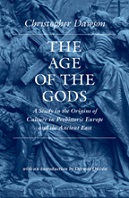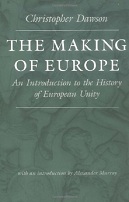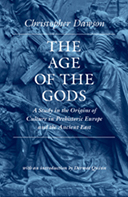The Age of the Gods was Dawson’s first published work, the fruit of many years of intensive study into prehistoric and ancient cultures. The articles he contributed to scholarly journals such as The Sociological Review and his lectureship in the history of culture at the University of Exeter, enabled him to create a structure for a planned 5-volume history of culture of which The Age of the Gods was to be the first volume. Published in 1928 by John Murray, it was acclaimed by important figures of the time such as the archaeologist Gordon Childe, who praised the author’s skill in presenting the “dry bones of archaeology” in an interesting way.
Central Themes
The Age of the Gods gives the impression of being so well researched that most of it remains valid today, around 85 years later. In the early chapters, it is fascinating to see his treatment of ‘Piltdown man’, which was believed to be genuine at the time. Without knowing that it was a forgery, Dawson notes certain inconsistencies in the evidence.
In the sections on ancient civilizations such as Egypt, he produces a brilliant overview, laced with interesting curiosities, such as the marked similarities between ancient Egypt and Inca Peru, with their theocratic governments and solar worship. He also points out the enduring effects of the Egyptian administration, claiming that it “exerted a vital formative influence on the tradition of European state administration through its inheritance by the Hellenistic monarchies and the Roman Empire.”
What really makes the book stand out, however, is the author’s sympathetic understanding of the ancient and prehistoric cultures, following his own maxim that “a culture can only be understood from within”. All the ancient cultures were religious in nature, and Christopher Dawson, as well as being a painstaking historical researcher, was a religious man. It is this quality that enables him not only to understand many aspects of the ancient cultures, but also to illuminate them with perceptive and original insights.
In the early part of the book, he defines religion in the following terms: “Wherever and whenever man has a sense of dependence on external powers which are conceived as mysterious and higher than man’s own, there is religion.” Thus, he asserts, “the religious instinct is part of the nature of man”, anticipating the term “Homo Religiosus”, later coined by Mircea Eliade.
With this approach, combined with a great power of imaginative deduction, Dawson is able to bring us closer to the living reality of the ancient cultures. In his treatment of Stonehenge, for example, he uses the knowledge of Celtic customs that have come down to our days (such as the coronation ceremony in Westminster Abbey) to explain the veneration paid to sacred stones. Using the same methods he also clarifies the importance given to ancestor worship and how it was linked to the solar cult. He concludes with a very English understatement: “…so we can imagine this circle having had a strong ritual element.”
Evaluation of the Work
The fact that the work was republished in 1970 and now again in a new edition in 2012, is a measure of its enduring quality. The depth and accuracy of research has also contributed to its lasting appeal. But its greatest attraction is that, for readers who already have some familiarity with the ancient and prehistoric cultures, Dawson’s work brings a new light to certain areas that are otherwise obscure, through his historian’s imagination and his sympathy with the religious spirit of ancient times.
PRAISE FOR THE ORIGINAL EDITION:
“…the best short account of our knowledge of prehistoric man, especially since the dawn of the Bronze Age, that has so far been written.” – Times Literary Supplement (1928)



